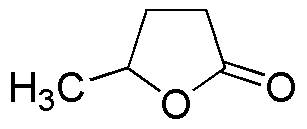g-Valerolactone is widely utilized in research focused on
- Solvent Applications: This compound serves as an effective solvent in various chemical reactions and processes, particularly in the production of polymers and pharmaceuticals. Its ability to dissolve a wide range of substances makes it a valuable resource in laboratories.
- Biodegradable Plastics: g-Valerolactone is a key ingredient in the synthesis of biodegradable plastics, offering an environmentally friendly alternative to traditional petroleum-based plastics. This application is particularly relevant in industries aiming to reduce their ecological footprint.
- Pharmaceutical Intermediates: It is used as an intermediate in the synthesis of various pharmaceuticals, enhancing the efficiency of drug development. Its unique properties allow for the creation of complex molecular structures that are crucial in medicinal chemistry.
- Flavoring and Fragrance Industry: The compound is also employed in the formulation of flavors and fragrances, providing a pleasant aroma and taste in food products and cosmetics. This application highlights its versatility beyond industrial uses.
- Energy Storage Solutions: g-Valerolactone is being explored as a component in energy storage systems, particularly in the development of advanced batteries. Its potential to improve energy density and stability positions it as a promising candidate in the renewable energy sector.
General Information
Properties
Safety and Regulations
Applications
g-Valerolactone is widely utilized in research focused on
- Solvent Applications: This compound serves as an effective solvent in various chemical reactions and processes, particularly in the production of polymers and pharmaceuticals. Its ability to dissolve a wide range of substances makes it a valuable resource in laboratories.
- Biodegradable Plastics: g-Valerolactone is a key ingredient in the synthesis of biodegradable plastics, offering an environmentally friendly alternative to traditional petroleum-based plastics. This application is particularly relevant in industries aiming to reduce their ecological footprint.
- Pharmaceutical Intermediates: It is used as an intermediate in the synthesis of various pharmaceuticals, enhancing the efficiency of drug development. Its unique properties allow for the creation of complex molecular structures that are crucial in medicinal chemistry.
- Flavoring and Fragrance Industry: The compound is also employed in the formulation of flavors and fragrances, providing a pleasant aroma and taste in food products and cosmetics. This application highlights its versatility beyond industrial uses.
- Energy Storage Solutions: g-Valerolactone is being explored as a component in energy storage systems, particularly in the development of advanced batteries. Its potential to improve energy density and stability positions it as a promising candidate in the renewable energy sector.
Documents
Safety Data Sheets (SDS)
The SDS provides comprehensive safety information on handling, storage, and disposal of the product.
Product Specification (PS)
The PS provides a comprehensive breakdown of the product’s properties, including chemical composition, physical state, purity, and storage requirements. It also details acceptable quality ranges and the product's intended applications.
Certificates of Analysis (COA)
Search for Certificates of Analysis (COA) by entering the products Lot Number. Lot and Batch Numbers can be found on a product’s label following the words ‘Lot’ or ‘Batch’.
*Catalog Number
*Lot Number
Certificates Of Origin (COO)
This COO confirms the country where the product was manufactured, and also details the materials and components used in it and whether it is derived from natural, synthetic, or other specific sources. This certificate may be required for customs, trade, and regulatory compliance.
*Catalog Number
*Lot Number
Safety Data Sheets (SDS)
The SDS provides comprehensive safety information on handling, storage, and disposal of the product.
DownloadProduct Specification (PS)
The PS provides a comprehensive breakdown of the product’s properties, including chemical composition, physical state, purity, and storage requirements. It also details acceptable quality ranges and the product's intended applications.
DownloadCertificates of Analysis (COA)
Search for Certificates of Analysis (COA) by entering the products Lot Number. Lot and Batch Numbers can be found on a product’s label following the words ‘Lot’ or ‘Batch’.
*Catalog Number
*Lot Number
Certificates Of Origin (COO)
This COO confirms the country where the product was manufactured, and also details the materials and components used in it and whether it is derived from natural, synthetic, or other specific sources. This certificate may be required for customs, trade, and regulatory compliance.

